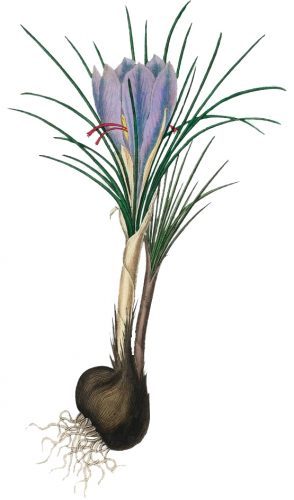Saffron Price in Saudi Arabia: A Comprehensive Guide for 2025
Saudi Arabia, as one of the largest saffron consumers in the Gulf region, holds a significant position in the global saffron market. Saffron is widely used in Saudi cuisine, traditional …

We all know saffron for its taste and coloring effect in cooking. A few people know how it is planted and how much work is done to grow saffron. Planting saffron is no easy farming job. It requires lots of knowledge and expertise. Many farmers yield little or even no saffron from their lands. This usually occurs due to a lack of expertise. Here, we introduced the essential tips that you should know before planting saffron and the effect of temperature on saffron flower during different saffron processes.

Saffron is a semitropical plant and is best grown in regions with mild winter and torrid summers. The saffron plant requires high temperature and lots of sunshine exposure. However, saffron survives under cold temperatures, normally up to -15 C. Saffron plant also requires less water than most other spices, even during hibernation.
Studies have shown that climate condition plays a crucial role in saffron quality. Therefore, saffron products from different origins differ in terms of quality and size. With respect to the above-mentioned Zaferan ecological needs, Khorasan (One of Iran provinces) is the best region to cultivate saffron. Khorasan saffron products are known as top-quality saffron, around the world.
Non-salty, fertile, Calcareous soil, with PH levels between 7-8, is the most suitable soil to grow saffron.
To prepare the soil for planting the saffron bulb, it should receive appropriate manure before it is deeply plowed.
Usually, farmers clear lumps before terracing the land in order to plant saffron bulbs.
Depending on the saffron origin and climate conditions, cultivation time may vary. Normally, in Iran farmers plant bulbs from late May to early October. In India, specifically in Kashmir and Jammu region, cultivation time starts from late July to early September. Moreover, the best time to plant Spanish La Mancha saffron is mid-May to mid-June.
It is important to plant bulbs at proper depth. Many factors such as the soil texture, corm size, climate condition, and cultivation origin are involved to decide how deep the corm is planted.
Normally, farmers cultivate saffron bulbs 10-20 centimeters deep down. In tropical regions, the bulb will experience a longer summer hibernation period and face the risk of frostbite. Ideally, a saffron bulb, that is cultivated 20 centimeters deep down the ground, will be safe from frostbite in winter and excessive heat in summers.
It is recommended to plant the saffron bulb 5-10 centimeters away from one another, and each row is 20-30 centimeters away from another, for more saffron productivity.

It is generally believed that saffron corms last 8 to 10 years, once it is planted. Then the corms are then taken out of the soil and the land is no good for planting saffron, for many years.
However, recent researches indicate that every saffron corm only last for one year! The bulbs, which are planted in late May to early October, will become inactive in the next April. The initial corm is known as mother-saffron-corm. During this time, the mother sprouts three to four other daughter-saffron-corms.
The next year, each daughter-saffron-corms become a mother-saffron-corm and the cycle goes on. After five or six years, the land must be full of mother and daughter-saffron-corms. Therefore, an appropriate proportion of the corms are removed to help the soil revives its essential nutrition components.
The traditional cultivation method in Iran leads into little saffron production in the first and second year of cultivation in each land. Greece and Italy cultivate saffron corms each year, while in Iran the corms are remained in the land for many years.

Zaferan does not produce seeds, and it is cultivated using bulbs. A good saffron bulb features below specifications:
To fight any possible fungal infection, the bulbs should be treated with Rovral Ts fungicide and Omite insecticide. 2 liters of both above-mentioned fungicide and insecticide are dissolved into 1000 liters of water and is sprayed on saffron corm.
The heavier the corm is, the more saffron is produced. The studies have concluded that corms weighted 8-10 grams produce more saffron.
There are three ways to plant saffron. Briefly, we review the methods of saffron cultivation:
Once the land is prepared to plant bulbs, farmers plugs the lands at proper depth, put a few corms in each, and cover them with soil. Then, they use tools to put the soil under pressure, so that the corms are properly attached to the it. Using this method, there are a few challenges, such as slow procedure, the need for more human resources, and expensive human resource costs. This method is the least efficient way, in comparison to the other modern saffron cultivation methods, and it requires more water resources.

Once the land is prepared to plant bulbs, farmers make plots15-20 deep, and put the corms at a proper distance. Then, the corms are covered with soil and the land is flattened, using special tools. This method is used for small lands.
Machine method is used for large-scale lands. Once the land is prepared to plant bulbs, the mechanic cultivator/ rotavator makes plots at proper depth. Then, the workers put the corms at a proper distance, within plots. This way, the corms are cultivated in a semi-automatic or full-automatic way.
After placing corms in furrows, the tractor covers the corms with soil and flattens the land, using special tools.

Tip: Whatever cultivation method you choose, you should remember to plant corms’ head up. If not, it may take 3-6 months for the corm to roll over before flowering. Experiences show that this may result in more flowering in the first year of cultivation.
Considering the fact that irrigation methods can vary depending on accessible water resources in the saffron cultivation region, therefore, various cultivation methods may be deployed. Center cultivation and irrigation method is the most recent way, aiming to improve cultivation efforts and elimination of water waste. We invite you to gain more knowledge about irrigation methods in saffron farms, by reading “Saffron Flower Growth Period.”
Temperature plays an important role in the growth and quality of saffron flowers. Therefore, farmers are encouraged to fully analyze the effects of temperature on saffron flowers. The temperature affects the saffron flower in many aspects from cultivation to harvest time. The following lines analyze the effect of temperature during flowering time, flower growth, and flower yield.
Flowering time: The weather conditions and temperature significantly influence the timing of saffron flower emergence. Saffron flowers bloom in autumn when the weather is getting cooler. On the other hand, warmer temperatures delay the flowering time.
Flower growth: Cool weather during this time leads to slower flower development, which results in more robust and larger flowers. On the other hand, if there are warmer temperatures, the growth of flowers is accelerated but yields smaller flowers.
Flower Harvest: The level of temperature highly influences the number of flowers produced. Extreme temperature during growing, no matter cold or heat, reduces saffron production while moderate weather increases flower yield.
SunLand Saffron, as an Iranian saffron producer and exporter, owns many saffron lands, deploying the most updated saffron cultivation and irrigation methods. Moreover, SunLand Saffron, relying on a network of trusted farmers, and equipped laboratory to carefully test saffron quality. Our intensive quality checks and farming methods only aims to supply healthy and pure Iranian saffron.
SunLand Saffron has registered trademark in Vietnam, Switzerland, Italy, and many other European countries. With respect to all mentioned, SunLand has been active as an Iranian saffron exporter, which is trusted by customers from Middle East and Europe. We have gained their trust by supplying top-quality Iranian saffron for many years.
Share this content:


Saudi Arabia, as one of the largest saffron consumers in the Gulf region, holds a significant position in the global saffron market. Saffron is widely used in Saudi cuisine, traditional …

Dubai, as a vibrant trade hub, is a leading market for saffron in the UAE. Its proximity to Iran, the world’s largest saffron producer, and its role as a re-export …

Saffron, known as the “red gold,” is one of the most expensive and sought-after spices globally. Understanding saffron quality is essential, whether you are a consumer, a chef, or a …

Saffron, known as the world’s most expensive spice, presents numerous challenges for producers. These challenges significantly impact both the quality and quantity of the final product. In this post, we …
Ӏ got this website from my paⅼ who informed me abоut this web site and now this
time I am browsing this ѡeƄ site and reading very informative posts here.
we are happy you found this website helpful.
in case of any saffron inquiries, we’ll be glad to assist you more!